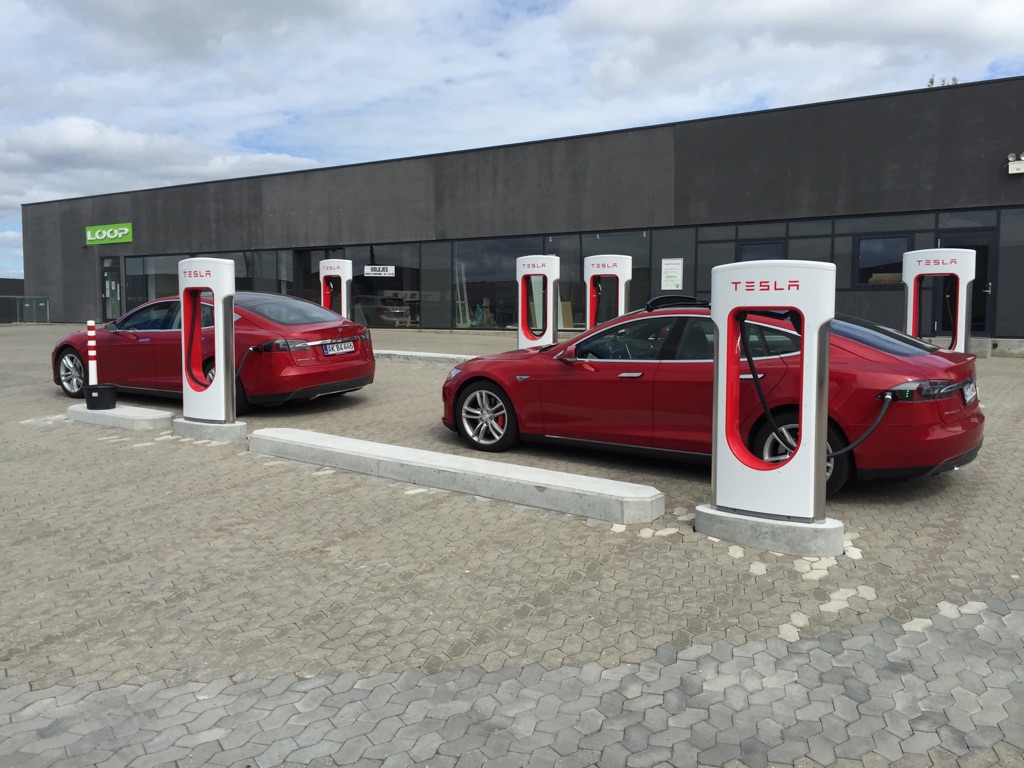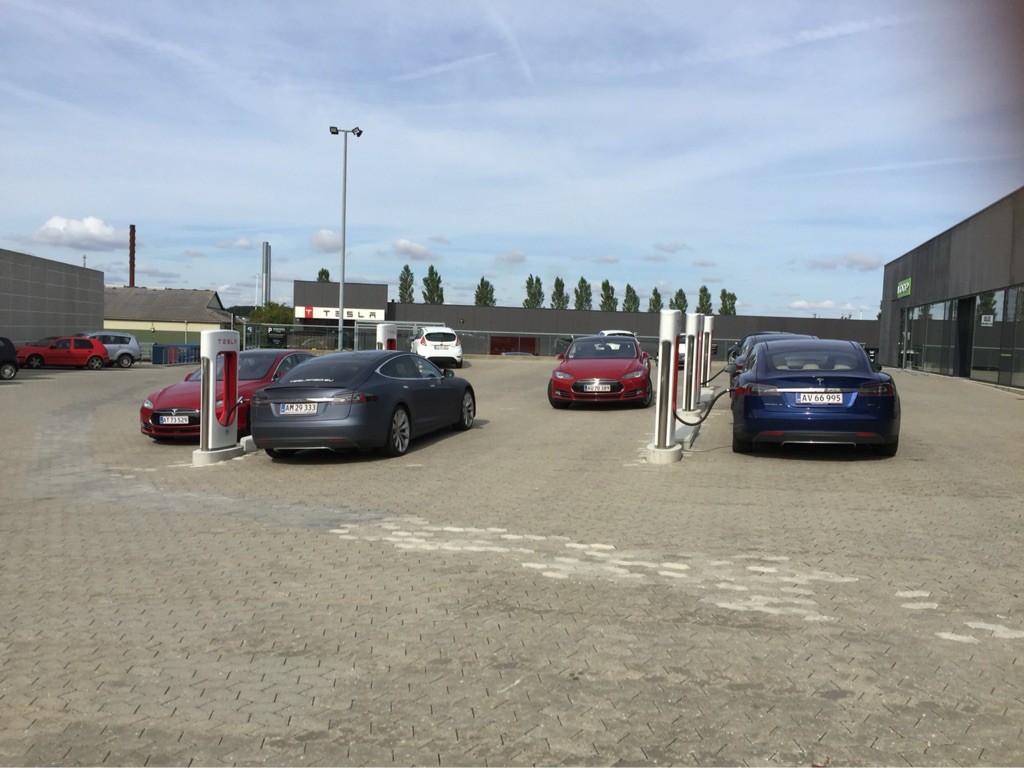News
Tesla Calls Danish Tax Plan A Death Knell For Electric Cars
Tesla says a plan by Denmark to phase in its 180% registration tax on electric cars is unfair and may be the death knell for electric cars in the country.


Tesla Service Center Aarhus-Viborgvej, Denmark [Source: Frederik C via Tesla Lifestyle App]
Tesla owners in Denmark have been exempt from the infamous 180% new car registration tax because of the government’s incentive for electric vehicles. That will soon change as Denmark is in the process of reassessing its national policies for reducing carbon emissions.
Just last week, Climate Minister Lars Christian Lilleholt said he will not push to meet Denmark’s existing goal of reducing emissions by 40% by 2020 because doing so will be too expensive for Danish businesses.
As part of that reassessment, a new Danish tax plan will phase in the registration tax on electric cars over the next 5 years. The government says doing so will be fairer to those who buy conventional cars and add almost $100,000,000 annually to the nation’s coffers. But Tesla, which makes the top selling electric car in Denmark, has slammed the plan as anti-competitive and a death knell for the industry. Under the plan, the price of a Tesla Model S P85D will soar from $131,250 (862,000 kroner) to more than $270,000 (1,807,100 kroner).
“All things being equal, this is not a phasing-in of levies on electric cars but rather a phasing out of electric cars in Denmark,” said Tesla’s Danish spokesman, Esben Pedersen, according to Danish media outlet, The Local. He said the plan, which will see prices on Tesla’s luxury models climb much higher than the increases on smaller and cheaper models, is unfair.
The company plans to file a complaint with the European Union. Pedersen tells Denmark’s TV2,
“We will contact the EU because we believe that the electric car agreement is anti-competitive and singles out Tesla. The deal will hit the entire electric car model and will eliminate it instead of developing it”
The Danish government defended the move, which has broad support from the Social Democrats, Danish People’s Party and Social Liberals. Tax Minister Karsten Lauritzen said that the new plan “balances the needs for the continued expansion of electric cars in Denmark, the public purse and fairness within the automobile market.”
“Electric cars have for a long time been better positioned than other cars by being completely exempt from the registration tax. Many regular Danes have a hard time understanding why they should pay the full registration tax for their regular cars while those who can afford an electric car have gotten off completely free,” Lauritzen said in a press release. 1,240 electric cars were sold in Denmark during the first six months of 2015 according to the European Automobile Manufacturers Association, nearly double the number bought in 2014.
Denmark’s rethinking of its plans to reduce carbon emissions comes just a few months ahead of the next global climate change conference, which will take place in Paris this December. While the new plan only seeks to reduce emissions by 37% instead of 40%, climate activists are calling the changes short sighted and dangerous.
Until this point, Denmark has been one of Europe’s “greenest” countries. It has made a significant investment in offshore wind power and actually produced 140% of its national electricity needs one day this past July. Its decision to re-balance its economic and sustainability objectives may be a preview of the thorny issues the international delegates will confront in Paris. It may also presage the policy debate that will take place in the United States when the current federal tax credit for electric cars expires at the end of 2016.

News
Tesla FSD fleet is nearing 7 billion total miles, including 2.5 billion city miles
As can be seen on Tesla’s official FSD webpage, vehicles equipped with the system have now navigated over 6.99 billion miles.

Tesla’s Full Self-Driving (Supervised) fleet is closing in on almost 7 billion total miles driven, as per data posted by the company on its official FSD webpage.
These figures hint at the massive scale of data fueling Tesla’s rapid FSD improvements, which have been quite notable as of late.
FSD mileage milestones
As can be seen on Tesla’s official FSD webpage, vehicles equipped with the system have now navigated over 6.99 billion miles. Tesla owner and avid FSD tester Whole Mars Catalog also shared a screenshot indicating that from the nearly 7 billion miles traveled by the FSD fleet, more than 2.5 billion miles were driven inside cities.
City miles are particularly valuable for complex urban scenarios like unprotected turns, pedestrian interactions, and traffic lights. This is also the difference-maker for FSD, as only complex solutions, such as Waymo’s self-driving taxis, operate similarly on inner-city streets. And even then, incidents such as the San Francisco blackouts have proven challenging for sensor-rich vehicles like Waymos.
Tesla’s data edge
Tesla has a number of advantages in the autonomous vehicle sector, one of which is the size of its fleet and the number of vehicles training FSD on real-world roads. Tesla’s nearly 7 billion FSD miles then allow the company to roll out updates that make its vehicles behave like they are being driven by experienced drivers, even if they are operating on their own.
So notable are Tesla’s improvements to FSD that NVIDIA Director of Robotics Jim Fan, after experiencing FSD v14, noted that the system is the first AI that passes what he described as a “Physical Turing Test.”
“Despite knowing exactly how robot learning works, I still find it magical watching the steering wheel turn by itself. First it feels surreal, next it becomes routine. Then, like the smartphone, taking it away actively hurts. This is how humanity gets rewired and glued to god-like technologies,” Fan wrote in a post on X.
News
Tesla starts showing how FSD will change lives in Europe
Local officials tested the system on narrow country roads and were impressed by FSD’s smooth, human-like driving, with some calling the service a game-changer for everyday life in areas that are far from urban centers.

Tesla has launched Europe’s first public shuttle service using Full Self-Driving (Supervised) in the rural Eifelkreis Bitburg-Prüm region of Germany, demonstrating how the technology can restore independence and mobility for people who struggle with limited transport options.
Local officials tested the system on narrow country roads and were impressed by FSD’s smooth, human-like driving, with some calling the service a game-changer for everyday life in areas that are far from urban centers.
Officials see real impact on rural residents
Arzfeld Mayor Johannes Kuhl and District Administrator Andreas Kruppert personally tested the Tesla shuttle service. This allowed them to see just how well FSD navigated winding lanes and rural roads confidently. Kruppert said, “Autonomous driving sounds like science fiction to many, but we simply see here that it works totally well in rural regions too.” Kuhl, for his part, also noted that FSD “feels like a very experienced driver.”
The pilot complements the area’s “Citizen Bus” program, which provides on-demand rides for elderly residents who can no longer drive themselves. Tesla Europe shared a video of a demonstration of the service, highlighting how FSD gives people their freedom back, even in places where public transport is not as prevalent.
What the Ministry for Economic Affairs and Transport says
Rhineland-Palatinate’s Minister Daniela Schmitt supported the project, praising the collaboration that made this “first of its kind in Europe” possible. As per the ministry, the rural rollout for the service shows FSD’s potential beyond major cities, and it delivers tangible benefits like grocery runs, doctor visits, and social connections for isolated residents.
“Reliable and flexible mobility is especially vital in rural areas. With the launch of a shuttle service using self-driving vehicles (FSD supervised) by Tesla in the Eifelkreis Bitburg-Prüm, an innovative pilot project is now getting underway that complements local community bus services. It is the first project of its kind in Europe.
“The result is a real gain for rural mobility: greater accessibility, more flexibility and tangible benefits for everyday life. A strong signal for innovation, cooperation and future-oriented mobility beyond urban centers,” the ministry wrote in a LinkedIn post.
News
Tesla China quietly posts Robotaxi-related job listing
Tesla China is currently seeking a Low Voltage Electrical Engineer to work on circuit board design for the company’s autonomous vehicles.

Tesla has posted a new job listing in Shanghai explicitly tied to its Robotaxi program, fueling speculation that the company is preparing to launch its dedicated autonomous ride-hailing service in China.
As noted in the listing, Tesla China is currently seeking a Low Voltage Electrical Engineer to work on circuit board design for the company’s autonomous vehicles.
Robotaxi-specific role
The listing, which was shared on social media platform X by industry watcher @tslaming, suggested that Tesla China is looking to fill the role urgently. The job listing itself specifically mentions that the person hired for the role will be working on the Low Voltage Hardware team, which would design the circuit boards that would serve as the nervous system of the Robotaxi.
Key tasks for the role, as indicated in the job listing, include collaboration with PCB layout, firmware, mechanical, program management, and validation teams, among other responsibilities. The role is based in Shanghai.
China Robotaxi launch
China represents a massive potential market for robotaxis, with its dense urban centers and supportive policies in select cities. Tesla has limited permission to roll out FSD in the country, though despite this, its vehicles have been hailed as among the best in the market when it comes to autonomous features. So far, at least, it appears that China supports Tesla’s FSD and Robotaxi rollout.
This was hinted at in November, when Tesla brought the Cybercab to the 8th China International Import Expo (CIIE) in Shanghai, marking the first time that the autonomous two-seater was brought to the Asia-Pacific region. The vehicle, despite not having a release date in China, received a significant amount of interest among the event’s attendees.









